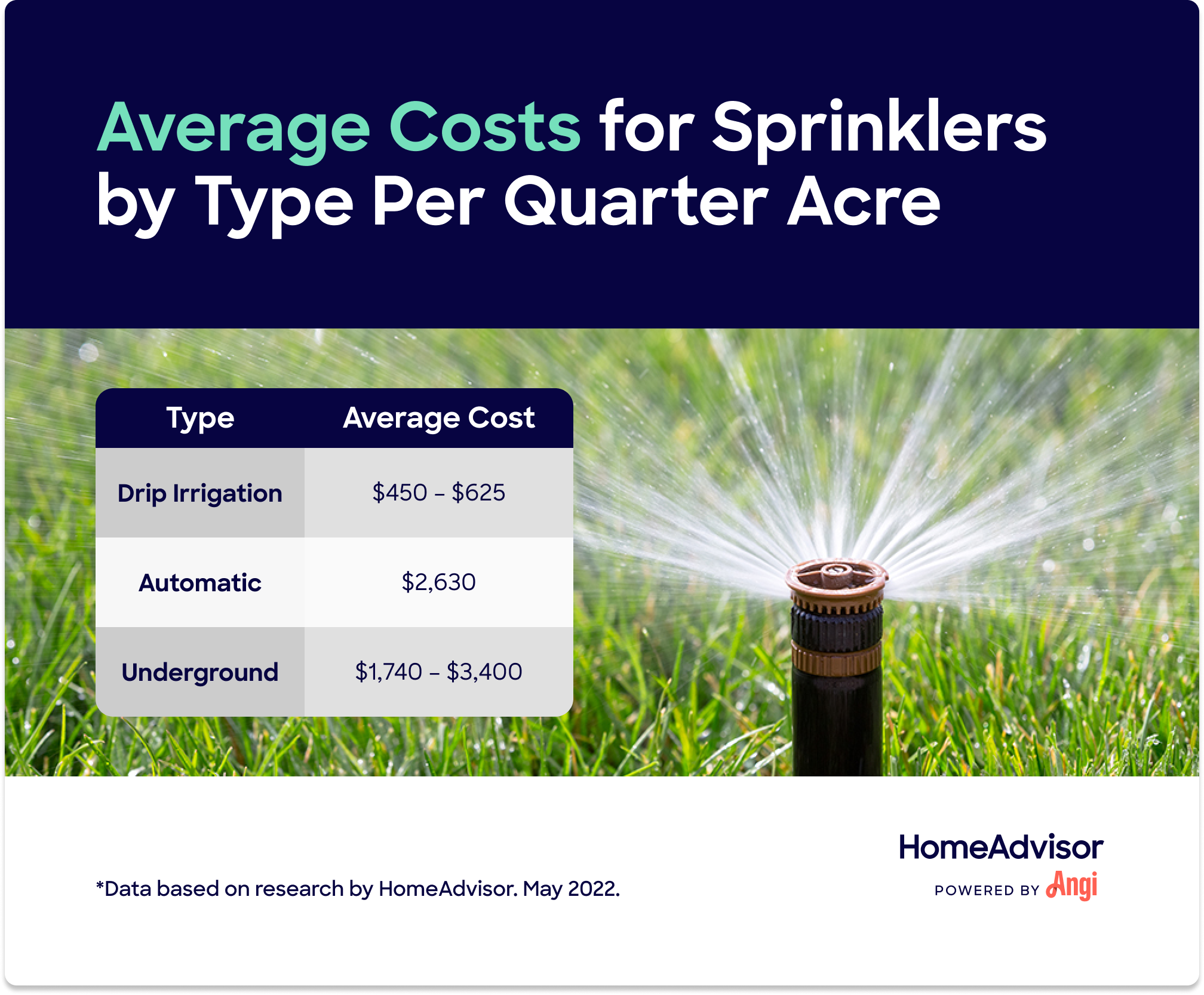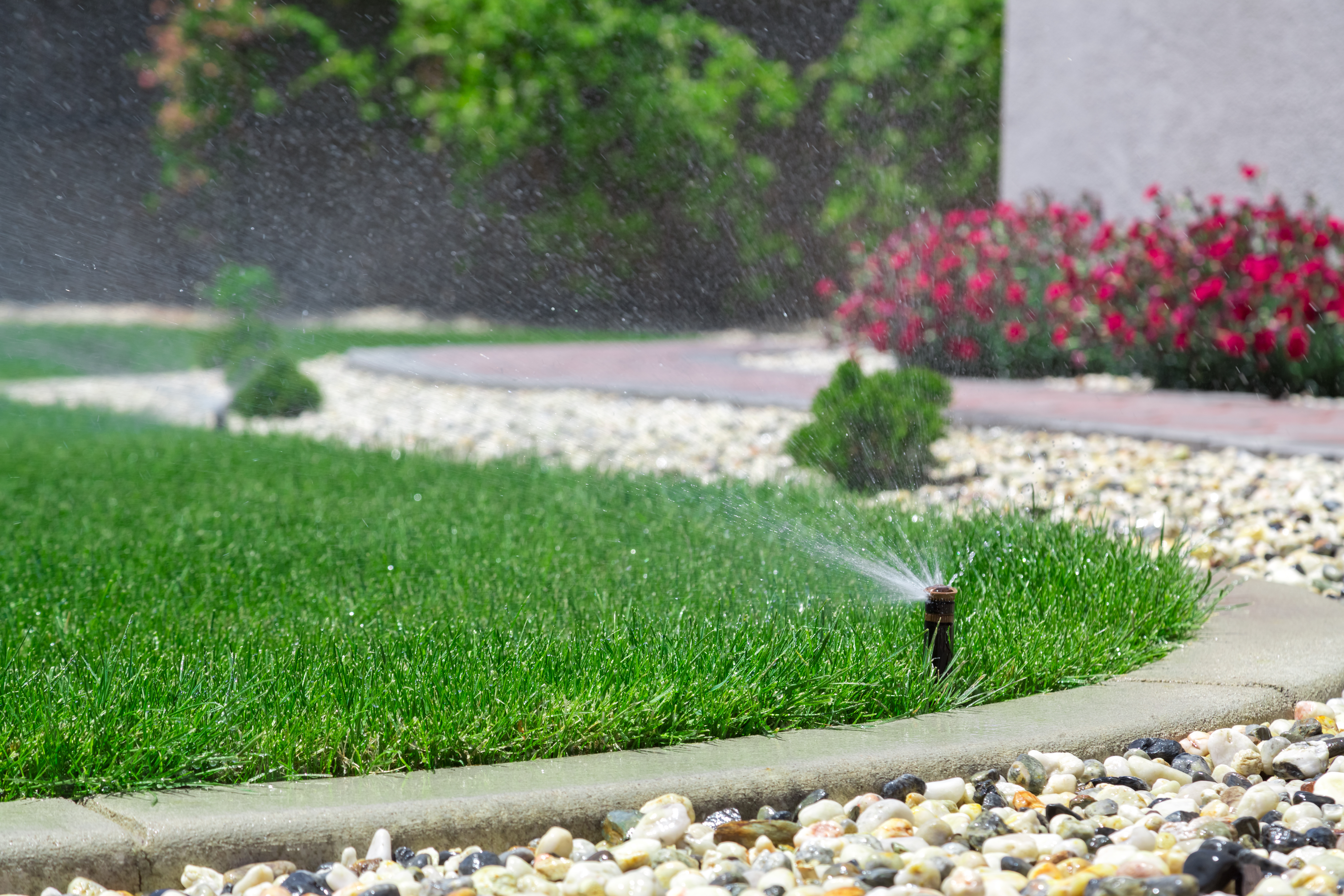How Much Does It Cost to Install a Sprinkler System?
Typical Range:
$1,640 - $3,566
Typical Range:
$1,640 - $3,566
Cost data is based on actual project costs as reported by 8,024 HomeAdvisor members. Embed this data
.
.
.
.
.
.
.
.
.
.
.
.
.
.
.
.
.
.
.
.
.
.
.
.
.
.
.
.
.
.
•
•
•
•
Updated April 16, 2024
Written by HomeAdvisor.Hiring a pro for sprinkler system installation ensures correct zoning, trenching, and system complexity for varied landscaping needs.
The average cost to install a sprinkler system ranges from $1,740 to $3,400 for a quarter-acre residential lawn.
The cost of sprinkler system installation is impacted by the total number of zones, trenching requirements, plants and landscaping needs, and potential reseeding or resodding of the yard.
Sprinkler system installations often require materials like sprinkler heads, pipes, and automatic controllers.
Installing a sprinkler system can increase home value, improve curb appeal, and conserve water.
Highlights were summarized from this existing cost guide text using automation technology and were thoroughly reviewed for accuracy by HomeAdvisor Editor Ryan Noonan.
Sprinkler system installation costs $2,540 on average, or between $1,695 and $3,530. The size of your yard and the quality of the materials make the biggest difference in price, with large, complex sprinkler irrigation systems costing nearly $10,000 per acre.
Let's calculate cost data for you. Where are you located?
Where are you located?
| National Average | $2,527 |
| Typical Range | $1,640 - $3,566 |
| Low End - High End | $300 - $5,070 |
Cost data is based on actual project costs as reported by 8,024 HomeAdvisor members.
Many factors go into the final cost of a sprinkler system installation. Everything from the layout of your property to your existing plumbing can have an impact. It’s a good idea to hire a land surveyor to tell you where your pipes exist already before starting this project. Here are a few things a pro will consider before providing a price estimate:
Small gardens may only have one or two zones with a simple sprinkler or two in each. Larger gardens with varied landscaping usually have multiple zones, and the more complex the system, the higher the cost. A pro can set your system to water zones at different times of day, or with varying amounts of water.
| Number of Zones | Cost |
|---|---|
| 1 | $500 - $1,000 |
| 2 | $1,000 - $2,000 |
| 4 | $2,000 - $4,000* |
| 6 | $3,000 - $6,000* |
| 7 | $3,500 - $7,000* |
*Some pros charge less per zone as the number of zones increases
Trenching an underground system costs $4 to $12 per linear foot. The amount of trenching required depends on the coverage area of your sprinkler heads and the complexity of the system.
A small lawn may only require one or two basic sprinklers to provide a consistent flow of water. In yards with a variety of landscapes, more complex (and expensive) sprinkler systems to cater to the different plants and groundcovers are necessary.
Delicate water-loving flowers and vegetables need gentler spray heads and bubblers; using standard lawn sprinklers could bruise or irreparably damage these plants. Tall plants and shrubs often need high-rise sprinklers, and large lawns sometimes need different sprinkler heads to provide varying amounts of irrigation to their sunny and shady sides.
If you use a reputable professional to install your sprinkler system, any damage to an existing lawn will be minimal and often disappears with time. However, if there’s noticeable damage and you want to quickly remedy any bare patches, you can reseed or resod those areas. If you don’t want to do this job yourself, the professional cost to resod a lawn runs from $1 to $2 per square foot, including materials. Expect the cost for reseeding your lawn to be between $0.09 and $0.18 per square foot.
With good maintenance and repairs, a quality sprinkler system can last upwards of 20 years. The cost to repair or replace a sprinkler valve runs from $12.50 to $40 before labor costs. Sprinkler head replacements cost $2.50 to $30 per item before labor. Timers cost anywhere from $10 to $325 depending on features and the number of zones. Installing a residential irrigation pump costs about $80 to $500 or more, plus the cost of labor.
If you're replacing an old system, expect a pro to charge from $50 to $100 per hour of labor to do this. Although some pros can install a new system without needing to remove the old one.
If this is your first sprinkler system and you didn’t water your lawn manually much before, expect to see a rise in your annual water bills.
Many areas require homeowners to have a permit in order to install a sprinkler system. They typically cost from $50 to $200. Check with your local municipality to see the requirements and costs in your neighborhood.
The size of your property plays a big role in how much you’ll pay.
| Area | Average Total Cost |
|---|---|
| Square foot | $0.20 - $1 |
| One-quarter are | $2,460 |
| One-third acre | $3,280 |
| One-half acre | $4,920 |
| 1 acre | $9,840 |
| 2 acres | $19,680 |
| 2.5 acres | $24,600 |
| 5 acres | $49,200 |
Installing an irrigation system on a one-quarter acre lawn costs from $450 to $3,400. Underground options are generally more expensive than drip irrigation.
An underground sprinkler system costs anywhere from $1,740 to $3,400 to install on a one-quarter acre residential lawn. Larger lawn areas and yards with multiple zones will cost more to irrigate. This project requires you to pay the cost to dig a trench, purchase materials, and complete the installation.
The price of a drip irrigation system runs from about $450 to $625 per quarter acre. Drip lines sit on top of the ground rather than being buried. They’re often more efficient than other watering methods.
An automatic sprinkler system costs $2,630 on average for a one-quarter acre yard. This includes the cost of an automatic controller, which runs from $10 to $325 on average. The most expensive options are typically smart controllers and ones that can be adjusted from your phone.
Labor costs to install a sprinkler system vary based on the type of system, but typically fall between $50 and $100 per hour. Above-ground sprinklers are among the easiest to install, generally taking 2 to 4 hours. Complex underground systems can take t 8 to 16 hours to install.
You can save money installing a sprinkler system yourself, but it’s a labor intensive job that requires technical know-how and the right equipment. Plus, you won’t have the reassurance of a warranty should anything go wrong.
You might be able to make some savings by digging the trenches for an underground system yourself and leaving the installation to the pros, but take advice to ensure you get the positioning and depth right.
If you have a large lawn or a landscape with complex watering needs, installing an irrigation system can be a good long-term investment. It’s a convenient and consistent way to improve your home’s curb appeal.
Though the upfront cost of a sprinkler system may seem daunting, it can actually save you money on your water bills. Sprinklers evenly distribute water across the yard and allow you to set the time and duration of each watering. This conserves water and increases the efficiency of your lawn irrigation.
A sprinkler system can increase your home’s curb appeal and add value. If you have dry, crispy grass, then watering it regularly will keep it green and fresh.
You can install a sprinkler system anytime after the last frosts, once new growth is appearing on your lawn. Avoid winter installation. The ground can be frozen, making it difficult to dig and the system needs to be winterized, so you won’t get a chance to test it until the following spring.
Fall can be a good time for installation. Professionals are typically less in demand than in the spring, so you might get a better price. Also, because temperatures are cooler and the grass is less stressed, it should bounce back better from any damage.
The number of sprinklers you have in a zone depends on your home’s water pressure (in gallons per minute), the flow rate of the individual sprinkler heads and the total number of zones. Rotor sprinkler heads, for example, cover a larger area than spray sprinkler heads, so you’ll need less of these. Your professional installer will help you make the right calculations to avoid problematic drops in pressure.
Professionals typically install sprinkler pipe lines 8 to 12 inches below the ground surface to protect them against hard frosts and damage from lawn care tools. The sprinkler heads (which can be anything from 2 to 20 inches tall), should retract so they are sitting almost flush with the ground when not in use.

